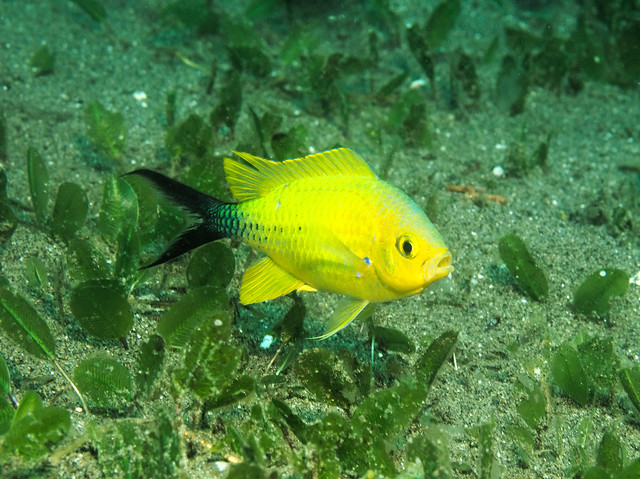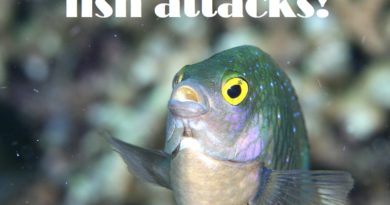Chromis viridis Mating Aggregation
“A lek is an aggregation of male animals gathered to engage in competitive displays, lekking, to entice visiting females which are surveying prospective partners to mate with” – Wikipedia
I recently had the pleasure of seeing what looked like a lek of a damselfish, Chromis viridis, in Dauin, on Negros Island in the Philippines. Normally these fish are colored light greenish-blue. During this mating aggregation, however, the males turned yellow and black. There were differently colored males, from slightly more yellow than the females, with black fin edges, to completely yellow ones with a black dorsal fin.
Males would defend a patch of sand with seaweed. The females would mate with the males 1:2, or groups of ~ 10 females would converge onto one spot, where they would seemingly mate with one male.
The whole spectacle took place about 5 meters deep. I watched and filmed for about an hour, and the fish were still going at it when I returned to shore.
A female fish:
A male with partial coloration change:
A fully yellow male:
For what it’s worth, the moon was in its 3rd quarter, falling, and the tide was halfway between high- and low tide, falling, at 12-1 pm, when the mating aggregation happened. The site had been dived not at all or very little during the last 3 months due to covid-related restrictions.
Some footage of the spectacle:
Some Science
I found only a little bit of scientific literature on the topic:
Fujii, R., Kasukawa, H., Miyaji, K., & Oshima, N. (1989). Mechanisms of skin coloration and its changes in the blue-green damselfish, Chromis viridis. Zoological science, 6(3), p477-486.
Describe in quite some detail how the skin color change physiology works.
In a conference poster, Ketabi, R., & Jamili, S. (2017). Chromis viridis (Cuvier, 1830). (available at http://aquaticcommons.org/21217/) write about Chromis viridis’ reproduction in imperfect but charming English:
“When they are breeding, males turn more yellowish. The marriages area pair matter, but they take place grouped. The males chose for the nest, a small dimple dug in the sand, the dead branch of Madrepora or simply, one hospitable seaweed. Then they dance, moving up and down, like if they were jumping in side a virtual column of water, for attracting the attention of the females and show the competitors that is their place. Oviparous, distinct pairing during breeding. Eggs are demersal and adhere to the substrate. Males guard and aerate the eggs.“



